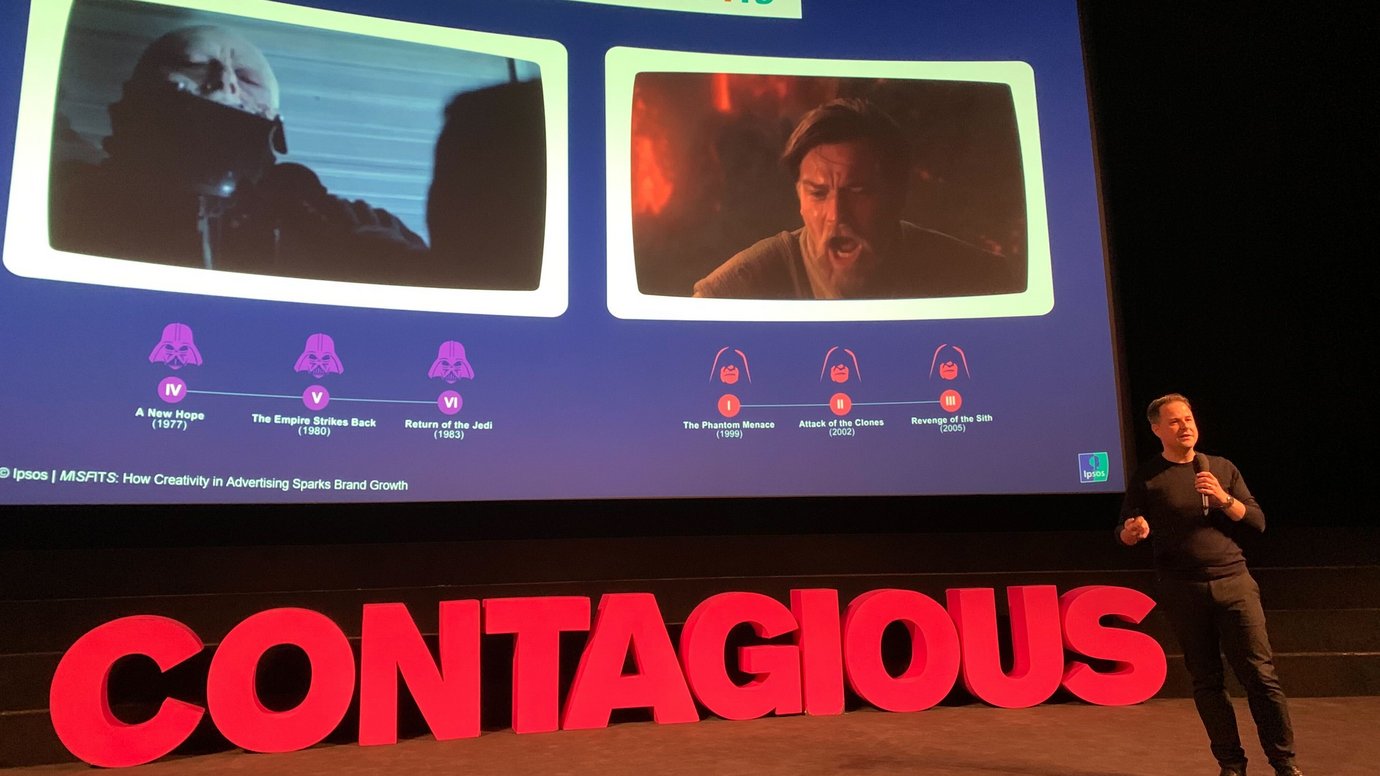Promoted content
Why true advertising creativity needs a mindset shift /
Ipsos’ global head of products and analytics, Adam Sheridan, on a new definition of advertising creativity that’s built on audience insights and sales.

For too long the everyday people who are vital to the success of advertising have been left out of discussions about creativity, argues Adam Sheridan, global head of products and analytics at Ipsos.
Sheridan was speaking at Contagious’ Mavericks and Mischief Makers event in London on 8 September, when he shared insights from Ipsos’ new book, MISFITS: How creativity in advertising sparks brand growth.
Sheridan began by describing the tension between creative agencies that want brands to take risks with their advertising and marketers that want to play it safe with tried and tested ideas.
But there’s a whole group of people who are missing from this debate, said Sheridan, which is the general public. And at Ipsos they have tried to alleviate this tension by understanding what ‘everyday people’ think creativity in advertising means.
Ipsos asked 20,000 people around the world what words or phrases come to mind based on the creative advertising they see. While ‘originality’ and ‘difference’ was at the core of the answers, there were also a lot of responses about a feeling of fun and entertainment, an appreciation of craft, and connecting with the messages in some way.
Consequently, Sheridan and Ipsos have developed a people-first definition of creativity in advertising: an original or different experience that has some value for the audience.
Applying this definition to popular culture, Sheridan looked at the Star Wars movie franchise, and specifically how the different trilogies performed at the box office.
He noted that the original and prequel trilogies, which both performed well financially, offered audiences new storylines. However, the latest trilogy of Star Wars films, which did not do so well, were, thematically at least, a rehash of the original movies – a young person of mysterious lineage goes on an adventure, rejects the hand of the villain, and at the end the villain is redeemed.
Sheridan added that while he would never claim there was a singular reason that explains the performance of the films, the latest trilogy was ‘bereft narratively of originality and difference’.
‘There is no interaction, and therefore, value for the audience,’ he said.
Coming back to advertising, Sheridan described a meta-analysis that Ipsos performed that helped it discern three categories of advertising experience.
‘The first is a creative experience,’ said Sheridan, ‘a feeling that the advertising was unique – it entertains you, and it's inherently talkable.
The second is ‘creative ideas’, which is less about the experience itself and more about the new concepts, values and options presented to audiences, which often lead them to viewing the advertised brand as different.
Finally, ‘empathy and fitting in’, which is about whether an ad matches expectations and feels like it was made/shown with you in mind, representing your world, needs, and challenges.
Entertaining an audience with a unique experience that's inherently talkable ‘is by far the surest way you can get to memory-encoding effects,’ said Sheridan, adding that these give brands an opportunity to influence customers’ choices and behaviours.
He described Heineken’s ads, in which the actor Daniel Craig is frequently mistaken for a character he plays, James Bond, as a good example.
‘Daniel Craig is consistently confused with his character of James Bond, and he cannot meet that expectation,’ said Sheridan, ‘and that evokes moments of humor in there for entertainment.
‘The question I posed in the book about this campaign and others is: is this advertising, or is it entertainment? And I would actually submit that it's both. And that's somewhat the point. Today, marketers need to be as much entertainers to pay that price of admission to be encoded in the mind as they are brand-builders to, in the end, sell products or grow market share.’
But creativity isn’t enough on its own to grow brands, warned Sheridan. ‘You can entertain with a unique story, but if you don't connect that story to the world of the people that you want to appeal to, you will regress to the mean.
‘But if you entertain with something unique that's inherently talkable, and frame it in their world, you will get a 20%+ sales lift versus the average, based on our sales validated metrics.’
Sheridan concluded with the point that creativity is about a ‘mindset shift’.
‘It's a mindset shift from developing advertising to sell products to consumers, to actually delivering a positive experience to audiences,’ he said. ‘And if you have that small mindset shift, the evidence confirms that, more often than not, advertising that is original, that connects with people in their world, will help you grow sales and market share.’
Check out Misfits to find out more about how Ipsos can help raise the bar on the quality of your advertising
Want more of the same? /
We don’t just write about best-in-class campaigns, interviews and trends. Our Members also receive access to briefings, online training, webinars, live events and much more.




